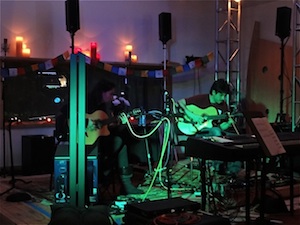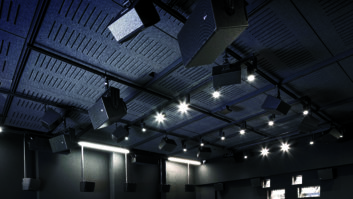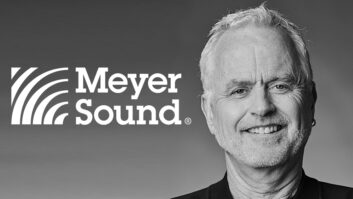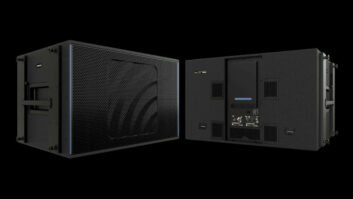
Rodrigo Y Gabriela record at Hans Zimmer’s Remote Control Productions in Santa Monica
Photo: Steve Ellison
Orchestral players feel more at ease in an acoustic environment that responds to the music they are performing, and that creates an ambience similar to the soundfield
found in a typical symphony hall. While working on film-score dates, the same sensibilities will favor a larger room capable of housing the orchestra or
section and producing a reasonable reverberation time at midrange- and high-frequencies.

Hans Zimmer produced the score and composed the theme music for Pirates of the Caribbean: On Stranger Tides
But what if the
room being used is small and offers a modest reverberation time? One solution, as discovered by the music team working on the recent Pirates of the Caribbean: On Stranger Tides film score, is to use a Meyer Sound Constellation Acoustic System to simulate the room acoustics of much larger spaces or environments that mimic the characteristic sound signature of landmark recording facilities.
“While planning to work on orchestral cues for Hans Zimmer’s score for Pirates of the Caribbean IV at Sony Pictures Studios’ Scoring Stage,” recalls scoring
mixer Alan Meyerson, “we heard about a Constellation system that had been installed there temporarily. The results were impressive—it sounded really, really good. Hans was interested in using the system to mimic the sound of Air
London’s large room [Lyndhurst Hall], one of his favorite spaces and one that has longer mid-frequency reverberation time than the Sony Stage, and a more ‘full’ and ‘warmer’ sound.” Zimmer has composed the scores for a large number
of hit movies, ranging from Inception and The Dark Knight through Pirates of the Caribbean:
The Curse of the Black Pearl to The Lion King.

Scoring mixer Alan Meyerson
Photo: Mel Lambert, content-creators.com
“We were very pleased with the results we achieved for string and brass sections recorded at Sony Scoring,” Meyerson continues, “and later at Hans’ post facility, Remote Control Productions in Santa Monica, where we recorded woodwinds and then Spanish acoustic guitar with the duo Rodrigo Y Gabriela using a smaller Constellation
system. At both Sony and RCP we were able to provide matching acoustics for the orchestral sections, and vary the RT60 to give us precisely the type of sound
and ambience we were after. The livelier acoustic also helped the orchestral players hear themselves in a more reverberant environment.” Daniel Kresco engineered
the RCP sessions.
While conceding that the Sony Scoring Stage is a “great sounding environment,” Meyerson
considers that “it doesn’t have the long reverberation time that Hans needed on some of the string cues” for Pirates IV. Also, because the 600-square-foot scoring stage at Remote Control is more compact, he says, “we could use the
Constellation system [while recording the woodwinds] to extend the RT60 and match it to the space in which we tracked the strings.” Meyerson reveals that the computer-based Constellation system was used to achieve a mid-frequency RT60 of up to three seconds. “We dialed in different settings for different cues, with appropriate levels and ‘colors,’ dependent upon what ambience we
needed.”

Sony Pictures Studios Scoring Stage
Photo: Steve Ellison
In contrast to conventional acoustic solutions, which range from moveable surfaces and powered drape systems to removable shell schemes, Meyer Sound’s Constellation
provides full user control of early reflections and reverberation parameters. A series of microphones suspended over the performance area captures the sound being generated within the space.

Sony Pictures Studios Scoring Stage
Photo: Steve Ellison
“Our D-Mitri digital audio platform then uses patented algorithms to generate signals that feed loudspeakers arrayed throughout the space,”
says Steve Ellison, Meyer
Sound’s applications director, digital products. “For the Sony Scoring
installation, we used 24 miniature cardioid mics, together with 18
UPM-1P overhead loudspeakers, a combination of 18 MM-4XP and MM-4XPD lateral loudspeakers, and eight M1D-Sub subwoofers,” located at pre-determined positions to provide balanced energy distribution
throughout the room while minimizing sound localization. “Constellation
creates a natural-sounding extension of the room’s physical acoustics,”
Ellison says. “Each installation
is tailored to the characteristics and demands of the space; the number
of channels and loudspeakers depends upon its size, natural
reverberation time and
the required power gain.”

Sony Pictures Studios Scoring Stage
Photo: Steve Ellison
A Constellation system was first installed at Sony Scoring to mimic the acoustics of Abbey Road’s legendary Studio One in London, UK, while recording
strings, brass and orchestra percussion sections plus choir for John Powell’s score to Mars Needs Moms. Subsequently, the system was used during the recording of James Newton Howard’s score for Green Lantern, and Trevor Morris’ music for an IMAX documentary, Tornado Alley.
“Constellation is a valuable tool in providing variable decay patterns for orchestral
sounds, particularly the midrange RT60, as well as adding ‘warmth’ to the sound,” Meyerson says. “We used individual room settings for long and short strings [for Pirates IV], and specific acoustics for the brass that produced a more ‘rounded’ and ‘open’ sound with fuller body.”

A smaller Meyer Sound Constellation system was set up in Hans Zimmer’s Remote Control Productions
Photo: Steve Ellison
“I love the sound of Air London,” Zimmer says. “My scores for the previous three Pirates
films captured a sound we have developed over the years, and which we
achieved at the Sony Scoring Stage. But I also wanted to achieve a bit
more of the sound I get in Air’s large Lyndhurst Hall. So, rather than
take a hundred musicians to London, I was able to bring a little of the
hall to my musicians. While Constellation doesn’t completely mimic the
sound of Lyndhurst Hall, we came
pretty close. I grew up working with larger concerts halls, including
Abbey Road and Air London; these are the type of spaces I like to use
for orchestral scores.
“We were able to make my scoring space [at Remote Control Productions]
sound very convincing for the musicians we used as collaborators. In
fact, one of the clarinetists
commented on the ‘big’ sound we achieved there. He looked up after one
cue and couldn’t believe that the wall was closer than he had believed
from the ambience
he’d been experiencing. And we could change the overall ‘color’ of the
room for the flamenco guitar cues that I wrote for Penelope Cruz’s
character in Pirates.
It’s a remarkable achievement in acoustics.”
“My top three reasons for liking Constellation?” Meyerson concludes.
“First would be the system’s ability to create different types and
shapes of rooms. I also like the highly
realistic illusion it provides for musicians and the film audience. And,
finally, I like the quality of the sound Constellation produces, which
is very convincing and not at all like an attached digital reverb.”
Find out more information about Meyer Sound’s Constellation Acoustic System.
Mel Lambert heads up Media&Marketing, a full-service consulting service for pro audio firms and facilities.







